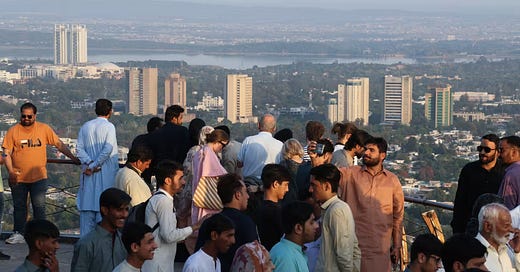Islamabad’s Green Cover Is Disappearing
Explore how a planned paradise is crumbling under the pressure of population and pollution
Dear readers,
I am excited to share my latest feature story for the Big in Asia section of Nikkei Asia, where I explore a troubling trend unfolding in Pakistan’s capital — a city once celebrated for its lush greenery and thoughtfully planned layout is rapidly turning into a concrete sprawl.
Islamabad was envisioned in the 1960s by Greek architect Constantinos Doxiadis as a serene capital city, blending modernity with nature. But decades later, that vision is under threat. The population has surged from under 200,000 to more than 2.3 million, and projections suggest this number could nearly double by 2050. As people pour in, the city's green cover is shrinking fast.
In this story, I dig into how unchecked urbanization is transforming Islamabad’s landscape. Iconic green spaces like the Margalla Hills National Park — once a peaceful haven and home to wildlife like leopards and wild boars — are now under pressure. The closure and demolition of the popular Monal restaurant, ordered by the Supreme Court on environmental grounds, marked a rare victory for conservationists. But it also highlighted just how far human encroachment had gone in one of the few truly green urban spaces left in Pakistan.
Pollution is getting worse. In December 2024, Islamabad recorded its most polluted month ever, with air quality levels so poor that outdoor activity was deemed unsafe. Residents now report persistent haze, increased allergies, and heat trapped by concrete infrastructure. The city, originally designed to be walkable, is now dominated by vehicles and construction.
Satellite data shows Islamabad’s built-up area ballooning from 6,655 acres in 1990 to over 45,000 acres by 2020. Meanwhile, forest cover has been cut nearly in half between 1989 and 2019. Though construction in green zones is officially prohibited under the original Master Plan, these regulations are being widely flouted.
This story also gives voice to those who live and work in the city — environmentalists, urban planners, real estate developers, and long-time residents. Some warn of looming environmental and livability crises, while others argue for sustainable development approaches like vertical housing and eco-friendly construction practices.
Islamabad may still be one of Pakistan’s more livable cities, but that status is precarious. As Earth Day approaches, this story is a timely reflection on the costs of unregulated growth and what must be done to preserve the city’s natural character.
You can read the full article here: Islamabad’s green vistas turn gray as population boom brings concrete wave
Warmly,
Adnan Aamir





